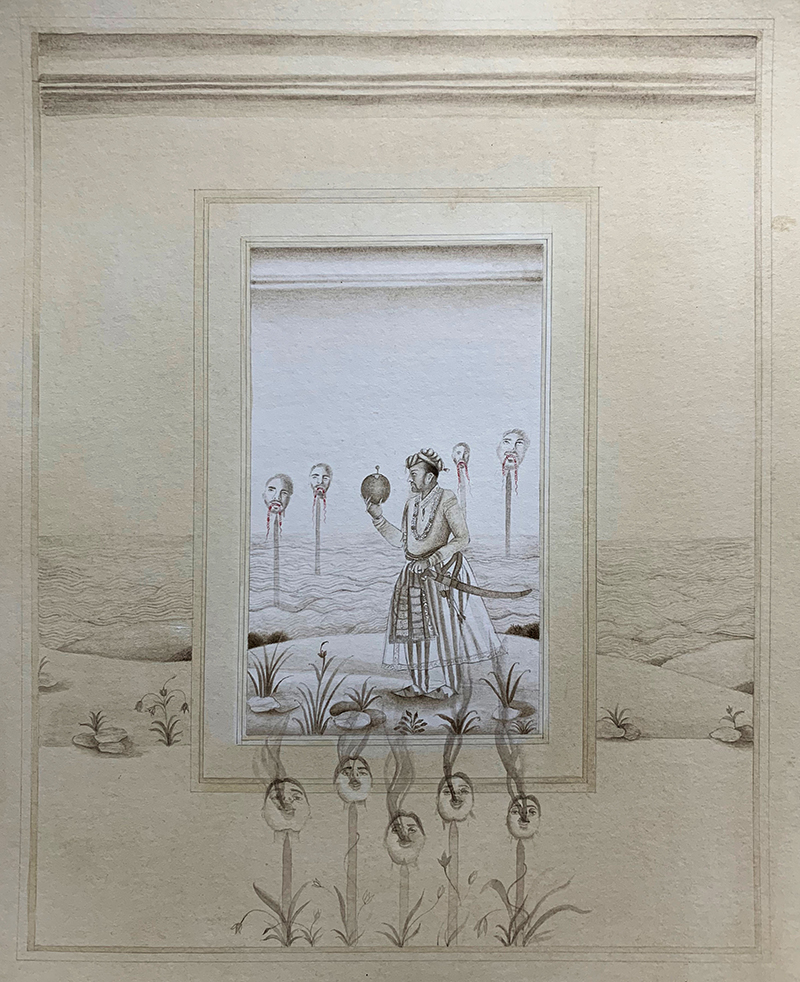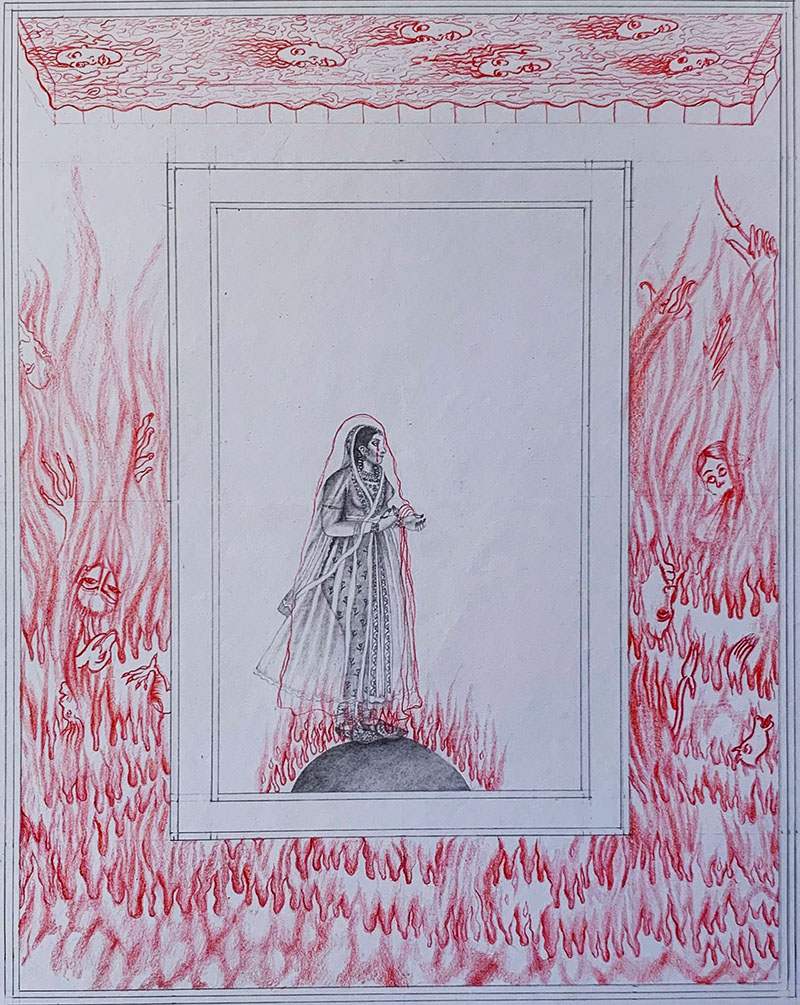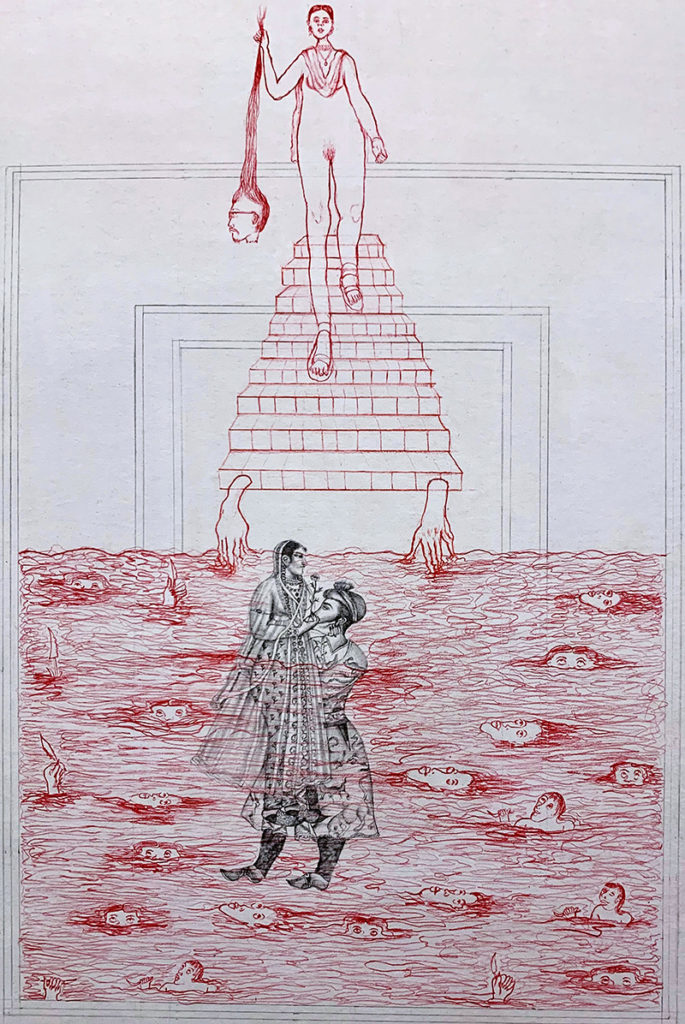If I could contribute with not only my own personal work but through creating forums that can work towards gaining independence from forces of orthodoxy, I would look to achieve that by contextualising my work within the larger discourse of contemporary art to continue my personal and professional growth as a person and an artist.
A glimpse of NY-based Pakistani artist, Sanie Bokhari’s early days in Pakistan, the challenges of being a woman artist and the thrill she derives from collaborative work and the energy of the Big Apple.

How did your tryst with art begin?
My grandfather was a polo player, so my mother was always surrounded by horses. I grew up being inspired by piles of her sketchbooks that had studies of the anatomy of horses, details of horse heads, eyes, hair et cetera. She was fascinated by its form and figure, movement and colours. I also came across a half-finished art school application that my mother never submitted. In South Asian culture, a serious career in the arts was never a thing or, at least in my experience, no South Asian parent ever considered that their child could seriously pursue it. So, my mother never applied. I knew I wanted to fulfil her dream and also challenge that notion. I knew I wanted to do something that would constantly challenge the society I grew up in.
Tell us about your collaborative piece at Selena’s Mountain. How did you two meet? What was your process, first piece? How did you divide your roles? How did you find balance?
Selena’s Mountain is a gallery in Brooklyn, New York. The curators, Michael and Olivia, came to my studio when I was at an art residency at the New York Art Residency and Studios (NARS) Foundation. I had an amazing time talking to them about my work, but as the residency ended, I ended up travelling quite a bit and have been a bit of a nomad since. I was in Lahore, London and Dubai, pursuing various art projects but NY always has a way of pulling me back in. I bumped into them almost seven months later at an opening at a gallery in Chelsea, NY and we reconnected.
I had been following every show they have curated so far. I always admired their perspective on the artists they chose to show and how they curated work. When they asked me to do a two-person show with Asif Tanvir Hoque, whose work I was already familiar with and had been following for a while, I was thrilled. They put everything together so seamlessly, in a way that I really felt they understood my work and his on a deeper level.

Can you tell us about your biggest learnings and hurdles along the way?
The high school I attended was a bubble, one with perfectly manicured lawns and teachers who spoke with affected accents. College was the complete opposite. It made me realise how much of Pakistan I didn’t understand. I sat in classes with Kashmiris, Balochis, Lahoris, and Sindhis. They taught me the intricacies of cultures within my own. I felt much more connected to my culture, my city, and the history of my country. However, looking back on that experience I wish I was taught more skills, and wasn’t constantly made to feel as if materials such as wood, metal et cetera are gendered and foundries and woodshops were only for men.
I learned I had the power to pursue a more serious career in art, where I had to let go of many relationships, people, ideas, values, time and so on. Finance is definitely a big hurdle for any artist, especially coming from Pakistan where the economy is in constant decline. Convincing my parents to be okay with leaving for grad school (RISD) was also a struggle, as I was a 26-year-old unmarried girl leaving the country to be by herself in a foreign land.
What inspires you? Take us through your frameworks and processes.
I take a lot of inspiration from art history: Mughal miniatures, Greek sculptures, old Egyptian paintings, Buddhist statues, religious Christian paintings, religious altars, ceramic tiles, textile tapestries etc. I also love looking at kinetic sculptures, and bring some of the same dynamics of movement in my two-dimensional work with overlapping drawings, and repetition in imagery. I wish to experiment with moving images, lenticular painting, and revolving mechanisms for future work.
My process involves sketching, planning a painting or a sculpture on Photoshop and, sometimes, making small cardboard maquettes if I am planning a large installation. The contemporary artists I look at for reference and who constantly inspire my work are Atul Dodiya, Shazia Sikander, Nicole Eisenman, Kara Walker, Rosa Loy, Hilma af Klint, Neo Rausch, Sigmar Polke, Bhupen Khakar, Nalini Malani, Lee Bontecou, Jutta Koether, R.B. Kitaj, Betty Woodman, and Mike Kelly.

What is the primary role of an artist?
Every artist has their own goals and reasons for creating, their backgrounds and intentions for pursuing this as a career and a life choice. I learned overtime that there is a great lack in the atmosphere of the art scene in Pakistani society, especially in terms of accepting women as independent individuals using art to make a living. If I could contribute with not only my own personal work but through creating forums that can work towards gaining independence from forces of orthodoxy, I would look to achieve that by contextualising my work within the larger discourse of contemporary art to continue my personal and professional growth as a person and an artist.
How do you deal with the conceptual difficulty and uncertainty of creating new work?
I have a huge archive of reference images of paintings, sculptures, photographs, advertisements etc. which I constantly turn to for inspiration. I also listen to a lot of different genres of music. My current series of work has elements of water, painted or drawn, which one of my favorite musicians Jamila Woods references in her album Legacy! Legacy! Her lyrics and music have been extremely relatable for me, especially for my current body of work.

How does your audience interact and react to the work?
I find it hard to explain my work to family or relatives who might not necessarily have an art background. I wish I was able to communicate my work better to people who didn’t go to art school or don’t know general art terms. I wish the art world was more universal and inclusive, but I also sometimes really enjoy the exclusivity of it. I love being surrounded by other artists, where how I interact and how I dress is never questioned or judged. I would say I have been pleasantly surprised by people interacting with my work who are just simply able to relate to the women I portray in my pieces.
What do you look for in other artists’ work? Any shows, performances or experiences that have impacted your creative process? Who are your maestros?
I am inspired by drawing as a medium more than anything and I often seek out drawing shows. My own colour palette is quite minimal and I am interested in works that involve fewer colours but convey the same information with lines. I also love seeing a painting that employs 3 dimensional elements which are used, not as a crutch, but convinces the viewer of its need, for instance the works of Robert Rauschenberg.
I love looking at oil paintings on canvas that skew perspective and use elements of foreshortening and distortion, but still remain close to reality, much like the way Kerry James Marshall executes his paintings. I would love to somehow see the process and get inside the mind of Marshall. I haven’t seen a better painting show than his retrospective at the Met Breuer in a long time. I think about that show very often.

What do you observe when you spend time with artists in flow?
I have worked with many artists and seen their process. I am always inspired by their confidence and energy in their workspace. I am constantly seeking that in my process and try to surround myself with people who are dedicated, ambitious and do not go a day without thinking about their work. I feel the most driven, challenged and happy in such environments. My experience living in New York matches that energy.
There are certain expectations as a woman in desi culture that I personally can’t relate to. Being abroad, I am able to detach myself from these expectations, which helps me focus on my career as an artist and more importantly, myself.
What is that one thing you wished people would ask you but never do?
I wish people in Pakistan would ask me about my work and my achievements, instead of why I am not married yet.
What are you working on now? What’s coming next season?
I want to go back to large-scale painting, but keep some of the aspects of what I have learned with miniature painting. I also have a show coming up at Kunstraum LLC, a gallery in Brooklyn. It will be up till mid-December. My show at Selena’s Mountain is also up till mid-December. I am very excited to wrap up this year with two shows and some very exciting reviews. Next season is still to be thought about, but I can’t wait to make more work.
As told to Sonalee Tomar for The Indian Curator












Add Comment